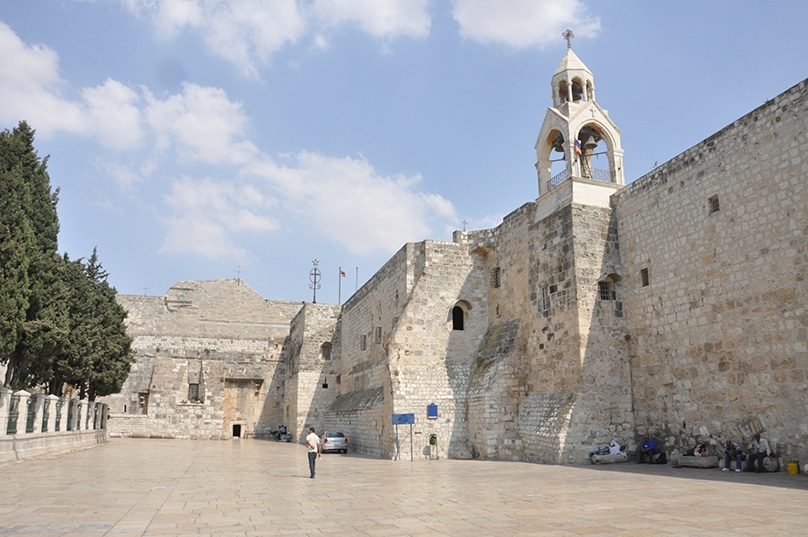
Dear Father John Flader, I understand that the Basilica of the Nativity of Christ in Bethlehem is one of the churches ordered to be built by St Helena in the Holy Land. What can you tell me about it?
Like practically all the Holy Land churches built in the early centuries, the Basilica of the Nativity in Bethlehem has gone through multiple changes over the years.
As you say, it is one of the three churches ordered to be built by St Helena, the mother of the emperor Constantine I during her visit to the Holy Land beginning in 325 AD. Since 2012 it is a UNESCO World Heritage Site.
Even before the basilica was built, Our Lord’s disciples and the early Christians were very much aware of the site in Bethlehem where Jesus was born and of its importance.
In the middle of the second century, St Justin, a native of Palestine, reported memories that were passed down from parents to children among the people of Bethlehem about the stable where Jesus was born (cf. Dialogue with Trypho, 78, 5).
Around 248 AD Origen testified that the place of Christ’s birth was well known locally: “In harmony with what the Gospels tell, people in Bethlehem show you the cave in which [Jesus] was born and, within the cave, the crib where he was laid, wrapped in swaddling clothes” (Contra Celsum, 1, 51).
With this enduring tradition, St Helena did not need to look as hard for the place where Jesus was born as she did to find the site of his crucifixion, burial and resurrection.
Nonetheless, it seems that here too Emperor Hadrian in 135, in order to prevent Christian worship, planted above the grotto of Christ’s birth a sacred wood dedicated to the god Adonis.
St Jerome writes: “Bethlehem, which now belongs to us, the most august place in the world, … lay under the shadow of a wood of Tammuz, or Adonis, and Venus’ paramour was mourned in the cave where many years ago Christ uttered his first cries” (Letters, 58, Ad Paulinum presbyterum, 3).
The basilica of St Helena was likely built sometime between 330 and 333 AD, and she was present for its dedication on 31 May 339.
Its grotto, marking the place where Jesus was born, is the oldest site in Christianity in continuous use as a place of worship, and the basilica itself is the oldest major church in the Holy Land.
Not much remains of this first basilica, which was destroyed during the Samaritan Revolt of 529. When peace was restored, Bethlehem was fortified and the Byzantine Emperor Justinian, who reigned from 527 to 565 AD, ordered a new, larger basilica to be built on the site of the first one.
This basilica still stands today, undoubtedly because the Persians, who in 614 destroyed almost all the other churches and monasteries in Palestine, saw in it a mosaic depicting the three wise men dressed in Persian garb.
It also survived the subsequent invasion by the Egyptian Caliph in 1009 and the many battles fought after the arrival of the crusaders in 1099.
The basilica, as it stands today, is 54 metres in length in the shape of a Latin cross, with five aisles lined with marble columns. One enters it through a small door, only one and a half metres high, made during the Ottoman period after 1516, intended to prevent the high and mighty from entering it on horseback, as they had done through the earlier much higher door. Known as the “door of humility,” it also invites the visitor to humble himself before entering the place where Christ humbled himself to be born in a stable.
In some places the remains of the mosaics that covered the floor of the basilica of St Helena can still be seen. On the walls above the columns there are beautiful mosaics from the time of the crusaders.
The focus of attention in the basilica is the grotto of the Nativity, located beneath the sanctuary in the form of a small chapel. Beneath the altar is a silver 14-pointed star which marks the place where Jesus was born.
There is a Latin inscription which translates as: “Here Jesus Christ was born of the Virgin Mary.” The 14 points are apparently intended to recall the 14 generations between Abraham and King David, fourteen between King David and the deportation to Babylon, and fourteen from the deportation to Christ (Mt 1:17).
A few kilometres to the East, in the town of Beit Sahour, Christian tradition has located the shepherds’ field, where the shepherds tended their flocks and the angels appeared to them at the birth of Christ. There are now two churches at this site.
